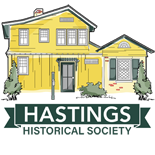The 1790 census: a page showing the numbers for Yonkers and Greenburgh.
The census you and I have just completed is the twenty-third national population count. Since the Constitution directs that a census be taken every ten years, it does not take very higher math to determine the date of the first census: 1790. Representatives to the first official Congress of the United States, which met in New York in 1789, were apportioned to the thirteen original states based on an estimate of their populations. But since the democratic ideal of the new government was representation based on exact numbers, the people had to be counted. All of them.
This job was assigned to the U.S. Marshals, the new law enforcement branch of the judiciary. The marshals of each district were empowered to hire assistants, who would be paid at the rate of $1 for each 150 persons counted in the open country, or $1 for each 300 if the assistant worked in a city. It was not a simple head count. Since the number of representatives for a state would be calculated based on the number of free citizens (not including Native Americans) plus three-fifths of the number of “others” (that is slaves), it was necessary to have separate counts for free people and for slaves. The 1790 census also enumerates males and females, and breaks free white men into two categories—those under 16 and those over 16. Historians theorize that the First Congress was trying to determine the size of the country’s workforce, and its military strength. Questions were raised immediately about the accuracy of the 1790 census. President Washington himself believed that the U.S. contained more than the reported 3.9 million people. But even so, the 1790 census is a fascinating source of information on early America, and Americans.
Hastings was not incorporated as a separate entity until 1879. The area that would later become our village appears on the 1790 census as part of the town of Greenburgh, which included everything from Hastings to Tarrytown, and as far east as the Bronx River. Greenburgh, as you can see here in a tabulation of its 1790 census information, had only 215 households, and a total population of about 1,400. This included 300 free white males over 16 years (208 were heads of their households) and 323 free white males under sixteen. Free white females numbered 616. In addition, there were 122 slaves, a little shy of New York’s average, which amounted to 12% of the population.
Detail of an 1880 copy of the 1785 map drawn up by the Commissioners of Forfeiture for New York showing how Philipse Manor was divided and to whom it was sold. In 1880 the map was redrawn and “updated” from supposedly more accurate records. The text in small caps has been added, including the word “Hastings”, and possibly also the position of the “school house” and the streets marked out in the center of the village.
The 1790 census does not record the name of every individual, only the heads of households. And there is no indication of where in Greenburgh each family resided, so we don’t know for sure who lived in our area. But several of the names on the census have a strong Hastings connection. Peter Post, keeper of the tavern at Five Corners and hero of a local skirmish with Hessian soldiers during the war, headed a household that included two boys under 16, six women, and four slaves. The other Hastings innkeeper, Evert Brown, whose tavern was on Broadway near the Yonkers border, had an even larger household of 19. This included seven slaves, making him the third largest slaveholder in Greenburgh.
Five years before the census had been taken, the state of New York had seized the property of loyalist Frederick Philipse, a manor that reached from Spuyten Duyvil to the Croton River. They sold the land off in lots, giving preference to those who lived on the land at the time. A map drawn up in 1785 gives the names of the purchasers. In the Hastings area, one of these plots went to Post, and the plot directly over the line into Yonkers went to Brown. Another was purchased by Jacobus Dyckman. Judging by the map, Dyckman owned a house on Broadway near Washington Avenue. His name also appears on the census as head of a household including seven men, three women, and three slaves.
George Fisher, who purchased the southernmost plot in Hastings, does not have a house with his name attached to it on the map, and is not even mentioned on the 1790 census. He appears to have sold his property relatively quickly to Adrian Leforge and James Fargee, both variations on the familiar Hastings name of Lefurgy. The northernmost plot in Hastings, running over the border into Dobbs Ferry, was bought by a man listed on the map as James De Clarke and on the census as Jacobus D. Clarke. A house with his name next to it can be seen on the map on what is now North Broadway. A slew of other familiar names appear on the 1790 census: Odells, Van Tassels, Van Warts, and also Abraham Dobbs, head of the family that ran the ferry crossing the Hudson to the north of us.
It is hard from these bare bones to get a feeling for what Westchester was like in the 1790s. In maps of Westchester from the time of the Revolution, our area was represented as nothing more than a roadway interrupted by two taverns. Much of Philipsburg Manor had been farming country, and the area continued to be largely agricultural into the 19th century. But if we follow the fortunes of the Lefurgy family, we can see hints of the changes that were to come for the Hudson valley. The Lefurgys were tenant farmers under the Philipses, landowners after the Revolution, and by the late 1790s they had become involved in shipping and the sloops, the maneuverable single-masted ships that carried furs, timber, fish, and passengers up and down the Hudson, encouraging local industry and paving the way for the future domination of steam and rail.

Watercolor of Philipsburg Manor and the Lower Mill at Yonkers, painted in 1784 based on sketches taken during the Revolution, one of the few images of any kind that gives us a feel for the rural character of Westchester in the late 18th century. (This watercolor is in the collection of Historic Hudson Valley, Tarrytown.)












This is known as 'The Van Bergen Over Mantle", a copy of which I sent to the Society many years ago when Fatima Mahdi was there, God bless her! This area is now the very large Larkin Plaza Parking facility. Bob Russell